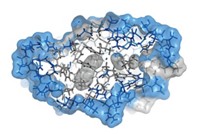Advertisement
Grab your lab coat. Let's get started
Welcome!
Welcome!
Create an account below to get 6 C&EN articles per month, receive newsletters and more - all free.
It seems this is your first time logging in online. Please enter the following information to continue.
As an ACS member you automatically get access to this site. All we need is few more details to create your reading experience.
Not you? Sign in with a different account.
Not you? Sign in with a different account.
ERROR 1
ERROR 1
ERROR 2
ERROR 2
ERROR 2
ERROR 2
ERROR 2
Password and Confirm password must match.
If you have an ACS member number, please enter it here so we can link this account to your membership. (optional)
ERROR 2
ACS values your privacy. By submitting your information, you are gaining access to C&EN and subscribing to our weekly newsletter. We use the information you provide to make your reading experience better, and we will never sell your data to third party members.
Biological Chemistry
Positive Charges Increase Protein’s Appetite Boost
Biochemistry: Small tweaks to the agouti-related protein could help cancer and AIDS patients gain weight
by Laura Cassiday
December 9, 2011

Tinkering with the sequence of a protein that stimulates appetite, researchers have produced a super-potent version that greatly increases weight gain in rats (ACS Chem. Biol., DOI: 10.1021/cb2003412). The work may help scientists develop treatments for cachexia, a body wasting syndrome associated with diseases including cancer and AIDS.

When the body needs energy, a hunger hormone stimulates neurons in the hypothalamus to secrete the agouti-related protein. This protein then binds to hormone receptors called melanocortin receptors on other nerve cells to block signaling. In turn, the blocked signal encourages the person to eat.
The agouti-related protein consists of a core domain flanked on either side by short stretches of amino acids. In 2002, Glenn Millhauser at the University of California, Santa Cruz, and his colleagues discovered that, compared to the full-length protein, the core domain alone could bind to melanocortin receptors on cells just as well (Biochemistry, DOI: 10.1021/bi012000x).
But Millhauser and his graduate student Michael Madonna wondered how the flanking regions influenced the protein’s function. They noticed that in many mammals’ version of the protein, the amino acid sequences of the regions are similar or the same, suggesting the sequences evolved for a specific purpose. The segments also are highly charged, containing five positively charged amino acids. The full-length agouti-related protein has seven positively charged amino acids.
To understand the role of these positive charges, Millhauser, Madonna, and their collaborators at the University of Cincinnati and the University of Alabama made a series of agouti-related protein variants by removing or adding positively charged amino acids to these flanking regions. To remove charge, they replaced the positively charged amino acid arginine with the neutral glutamine; to add charge, they exchanged other neutral amino acids with lysine. The team then injected the altered proteins directly into rats’ brains.
They found that a variant’s ability to stimulate the animals’ appetite increased linearly with the number of positively charged amino acids in the flanking regions. Compared to rats receiving the wild-type protein, rats injected with a protein containing four extra lysines ate 50% more food and gained twice as much weight over five days. “This result was stunning because up to this point, the wild-type agouti-related protein was the most potent known appetite-stimulating protein,” says Millhauser.
The data suggest that the agouti-related protein might interact with multiple neuronal receptors to stimulate hunger, Millhauser says: While melanocortin receptors bind the core domain, other, currently unknown, receptors may grab the charged flanking regions. Alternatively, he says, the positively charged residues may help shield the protein from degradation or target it to regions of the cell membrane that contain melanocortin receptors.
Greg Barsh at the HudsonAlpha Institute for Biotechnology in Huntsville, Ala., calls the appetite-stimulating effect remarkable. “We need new insights into basic mechanisms that regulate energy balance, and this work represents an important step in that direction,” he says.
Millhauser thinks the information may help cancer and AIDS patients. Those diseases and their treatments can suppress appetites, causing people to lose weight and break down muscle. He hopes to explore whether intravenous injections of the super-charged variant could help alleviate these symptoms.




Join the conversation
Contact the reporter
Submit a Letter to the Editor for publication
Engage with us on Twitter